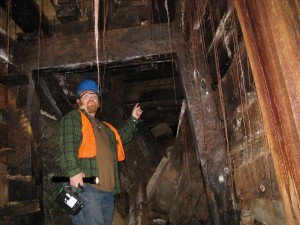A reminder: over the last weekend there was a swap of back end for the store which means, unfortunately, you cannot access your old pre-February 24th, 2012 orders to chat with me. The database should remember who you are but you’ll have to drop me a line the conventional way. Alas.
I get some personal questions from time to time in the ol’ Ask Herr Direktor bucket and the most popular is… Question: “What the hell is a health physicist and why are you one?” Answer: The completely uninformative TL;DR version is “a safety professional that specializes in ionizing radiation”.
Now, would you like to know what that means? This is a bit of a ramble, so brace yourself.
For a moment, please try to imagine ALL of Science. All of it, even the bits that you feel uncomfortable referring to as Science, perhaps you call it *finger quotes* “Science”, or squishy science, even perhaps pseudoscience. Are you holding all of that in your head? Okay, now take absolutely any topic in that ball of knowledge you’re holding and add ionizing radiation to further explore a hypothesis in the topic. In my experience, there is absolutely no field of human thought or endeavor that someone hasn’t found a way to add some kind of radioactive material tracer to or bombard with x-rays to prove a point.
It is vitally important to have someone around to say, “Okay, you could do that, but would you mind putting some shielding behind your target so you don’t irradiate the Chemistry 1A lab bench on the other side of the wall? At the very least, can you wait until after the students are gone?” One of the sayings about health physics is that it is a topic “an inch wide and a mile deep”. Understanding what radiation does is relatively easy; understanding what EVERYTHING ELSE does in the presence of radiation is another matter.
As a matter of history, x-rays were discovered by Roentgen in November 1895 and radioactive materials by Becquerel in July of 1896. The first recorded radiation injury happened due to an x-ray over exposure in August 1896; medical use of x-rays medical began shorty after the discovery. The term “health physics” entered parlance during the Manhattan Project to describe all those people doing radiation protection and biological research (mainly focused on their fellow workers/researchers handling radioactive materials) to protect us from their work and, sometimes, their work from them. On organizational charts and pay stubs “health physicist” was less informative to foreign intelligence services than “radiation protection professional/researcher”. In my opinion, the field as a whole has suffered from this obfuscation in the public eye ever since.
The effects of ionizing radiation, be it x-rays from a machine or radioactive materials, are pretty straightforward. We have an excellent idea of how much it takes to hurt people, how it hurts, and how to protect against it. In fact, ionizing radiation is wonderful because there are actually meters that can detect radiation directly. Biosafety and industrial hygiene (chemical safety) have been greatly hampered by the fact that tricorders don’t exist yet. But we’re getting there.
So what is it that I *do* exactly? Mostly paperwork. At the moment, I am responsible for the radiation producing machine (read: x-ray) and radiation detection instrument calibration program at UC Berkeley, which means I shuffle a lot of paper making sure everyone is playing nicely. This means making sure that machines are properly registered with the state (much like a registering a car with the DMV but you have 30 days instead of 7), that all the controls actually work AND are followed, that instruments stay in calibration and good repair, and that everything is used in a sane manner. The last thing in the world I want to see is “BABY’S FACE SCORCHED TO BONE BY ROGUE ACCELERATOR” because life doing radiation safety is difficult enough.

Another old adage is “The more interesting the job, the more paperwork they make you do.” I’d say a good 90% of my day is devoted to writing reports and reading regulations. But that 10% where I get to help a researcher build their experiment such that they expand human knowledge but don’t dramatically shorten their grad students’ lifespans, or go down into the mine that I didn’t know was there just to make sure radioactive materials weren’t stored there, or play Scooby Doo Adventures trying to figure out what happened in a lab 70 years ago to make that spot of mysterious contamination…THAT is what I love about being a health physicist.
In addition to all that above, I’m a teacher. I teach radiation safety at a local community college and a train people how to work with radioactive material & machines. I try, as much as I can, to try to get people to think about the world around them and appreciate it’s beauty and wonder, the electromagnetic spectrum being one of the most wondrous things to me. That’s the thing every scientist has in common, no matter how highly specialized they are, is that some part of the world is wonderful and they need to know more about it. At some level, the health physicist is the interface between people intensely interested in the world using radiation but not necessarily thinking of consequences and a public absolutely terrified of the very word. I think the phrase I used in my interview was “A health physicist has to be an ambassador for the isotopes.”
So, if you notice me trying to sneak the occasional tidbit of information about working with radiation to you, that’s part of my subversive effort to diminish some knee jerk ignorance in the world. Ionizing radiation is no different than fire: useful, beautiful, dangerous, deserving of respect. A health physicist is here to remind you to be respectful, play nice with the toys and the other children. In a way, we’re the recess yard duties of radiation.